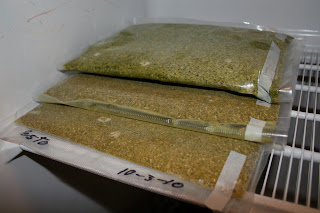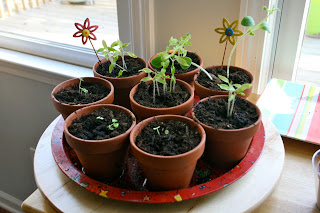So, now that you've bought or cooked all that food in bulk how do you preserve it? I’ve found that a few tools are essential to success when keeping goodies fresh for future use. Here’s a quick overview of what works for me:
Tools of the Bulk Trade
Vacuum seal – My FoodSaver is one of the most valuable tools in my preservation arsenal but I must come clean and tell you that I have a love/hate relationship with it. I LOVE that it allows me to vacuum seal just about anything, enabling me to freeze foods for months and months at a time. I vacuum seal meats, cheese and all our sauces (like tomato), spreads (like hummus and pesto), condiments (salsa) and broths. After sealing I lay flat and stack, like a bunch of books. However, the FoodSaver takes some practice and I’m the kind of gal that doesn’t have much patience for stuff that has to be aligned “just right” in order to work. All in all, it's a great tool and Foodsaver seems to be improving it all the time. (Please note that my Foodsaver is nearly 10 years old. Also, I'm not necessarily endorsing the FoodSaver brand, I'm sure there are many other sealing systems available...)
Freeze – About 6 years ago (just about the time I found out I was pregnant with twins) we found an inexpensive freezer at a “scratch and dent” sale. Since then it has saved us thousands of dollars because I can buy in bulk and freeze, freeze, freeze. I freeze just about everything, especially stuff I find on sale like milk, cheese and butter.
Can – Canning is easy, fun and a very effective way of keeping your food preserved. (Eating garden fresh tomatoes in the middle of December is such a treat. Homemade jam rocks the house.) It seems a lot of folks think that they need to have all sorts of equipment to can properly but all you really need is with a large pot. (You can pick one up for cheap at your local thrift store.) There are many great canning resources on the web and a huge variety of classes available. Check your local community garden or recreation center for more details.
Pickle – I am new to this and excited to pickle an enormous load of cucumbers this year. Seriously. I went a little nutso with the planting this year so I suspect will be SWIMMING in cucumbers around August... I’d better get this pickling stuff down right quick.
Ferment – I am inspired by my neighbor to ferment my veggies this year. Preservation by fermentation has been going on for eons and is a nutritious way to preserve veggies and more. Some say that fermentation actually improves the nutrition of foods. I can eager to try this soon.
Next up: Week 6 - Store-brand organics... A good, inexpensive option to brand-name items.
Organically yours,
Minde
Who has great resources on fermentation? Would love to hear about it...














